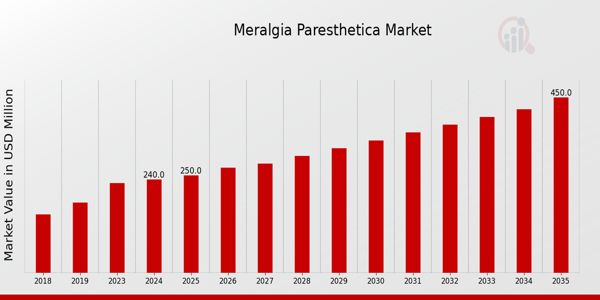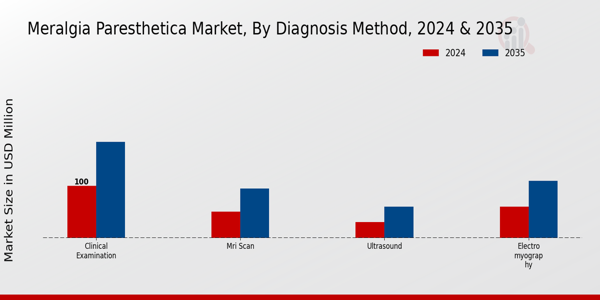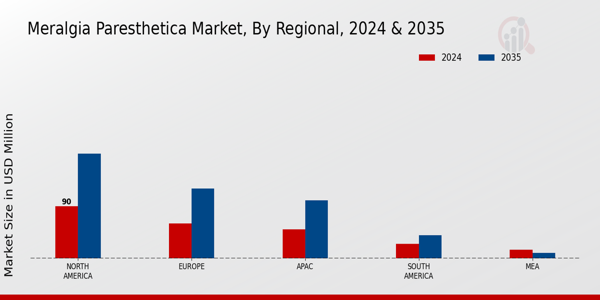Meralgia Paresthetica Market Overview
As per MRFR analysis, the Meralgia Paresthetica Market Size was estimated at 230 (USD Million) in 2023.The Meralgia Paresthetica Market Industry is expected to grow from 240(USD Million) in 2024 to 450 (USD Million) by 2035. The Meralgia Paresthetica Market CAGR (growth rate) is expected to be around 5.89% during the forecast period (2025 - 2035)
Key Meralgia Paresthetica Market Trends Highlighted
Driven by elements such as the rising prevalence of obesity, diabetes, and associated metabolic diseases, the Global Meralgia Paresthetica Market is seeing many significant developments. These health issues have caused an increase in nerve compression syndromes, notably meralgia paresthetica, which increases the need for efficient treatment choices. Moreover, as the world's population ages, more people will be vulnerable to different nerve-related disorders, which will heighten the need for medical treatments and therapeutic alternatives. Particularly via non-invasive techniques, the development of creative therapies and interventions for meralgia paresthetica offers significant possibilities.
The growing desire for substitutes for conventional surgical methods is driving interest in less invasive procedures, including nerve blocks or rehabilitation programs. Increasing knowledge among patients and healthcare providers about the signs and treatment choices for meralgia paresthetica is crucial if the industry is to expand. Recently, there has been a clear trend toward using telemedicine and online consultations, hence allowing patients to reach professionals more easily. This development indicates a more general drive toward digital health solutions, which may be especially important for diagnosing and tracking meralgia paresthetica.
Furthermore, continuous studies on the efficacy of different pharmacological and neuromodulatory treatments draw attention to the changing scene of treatment choices in the Global Market. The market is poised to change to fit these latest trends as players keep concentrating on enhancing patient outcomes and quality of life, hence guaranteeing prompt and efficient treatment for those suffering from meralgia paresthetica.

Source: Primary Research, Secondary Research, MRFR Database and Analyst Review
Meralgia Paresthetica Market Drivers
Increasing Prevalence of Diabetes Globally
A major impetus for the Global Meralgia Paresthetica Market Industry is the growing incidence of diabetes, especially in the Global setting. The International Diabetes Federation estimates that the worldwide population of persons living with diabetes has grown from 108 million in 1980 to 463 million in 2019, with forecasts indicating it will reach 700 million by 2045. Diabetic neuropathies develop with this rise in diabetes prevalence, which then causes more meralgia paresthetica from lateral femoral cutaneous nerve compression in individuals impacted.
Leading health authorities, such as the World Health Organization, have acknowledged diabetes as a significant public health concern, thereby raising awareness and pushing the need for efficient treatment choices in the marketplace.
Advancements in Diagnostic Technologies
Improvements in diagnostic technology are driving development in the Global Meralgia Paresthetica Market Industry. High-resolution imaging technologies like magnetic resonance imaging (MRI) and ultrasound have greatly enhanced the capacity to identify meralgia paresthetica precisely. According to the American College of Radiology, these technologies are becoming more widely available; MRI use for nerve-related diseases has risen 30% in the last five years.
This development is significant for market growth as it improves patient care techniques and helps in early diagnosis.
Growing Awareness of Neuropathic Disorders
Rising knowledge of neuropathic diseases, like meralgia paresthetica, is a key engine for the Global Meralgia Paresthetica Market Industry. Public health campaigns and educational initiatives run by groups such as the National Institute of Neurological Disorders and Stroke have increased public and medical professional knowledge of the signs and consequences of such diseases. Research shows that over 60-70% of diabetes patients might suffer some neuropathy, hence stressing the critical requirement of diagnosis and treatment.
This emphasis on awareness drives market expansion by increasing patient consultations and treatment-seeking behavior.
Meralgia Paresthetica Market Segment Insights
Meralgia Paresthetica Market Diagnosis Method Insights
The Global Meralgia Paresthetica Market is showing comprehensive growth with notable developments in the Diagnosis Method segment. By 2024, the market for Diagnosis Method is expected to showcase substantial revenues, with a diversified approach leveraging various techniques to enhance patient care and diagnosis accuracy. Among these, Clinical Examination plays a pivotal role, demonstrating the largest market share with a valuation of 100.0 USD Million in 2024, and is projected to rise to 185.0 USD Million by 2035, evidencing its time-tested significance as a primary diagnostic tool for clinicians.The rising prevalence of meralgia paresthetica, often characterized by tingling, numbness, or pain in the thigh, drives the demand for accurate and early diagnosis. Additionally, Electromyography is emerging as a crucial technique within this landscape, holding a market share of 60.0 USD Million in 2024, projected to increase to 110.0 USD Million in 2035.
This method allows clinicians to assess the electrical activity of muscles, thus aiding in the identification of nerve damage effectively. Furthermore, MRI Scan, valued at 50.0 USD Million in 2024 and expected to reach 95.0 USD Million by 2035, serves as a non-invasive imaging technique, providing detailed insights into structural abnormalities that may contribute to the condition.This reinforces the importance of precise imaging in diagnosing meralgia paresthetica, ensuring that underlying issues are accurately identified. Lastly, Ultrasound, while holding a comparatively lower valuation of 30.0 USD Million in 2024, is projected to grow to 60.0 USD Million by 2035, validating its emerging role in assessing nerve impingement and providing real-time guidance during diagnostic procedures.
The combination of these various methods contributes significantly towards the enhancement of the Global Meralgia Paresthetica Market industry.Continuous advancements in these diagnostic methodologies indicate a robust pipeline of opportunities and innovations aimed at improving patient outcomes, which is further stimulated by increasing awareness and the growing patient population requiring timely and efficient diagnosis. This facilitates a favorable climate for market growth, with effective utilization of clinical resources driving clinical examination and other methodologies to the forefront, thus shaping the future of meralgia paresthetica assessments globally.

Source: Primary Research, Secondary Research, MRFR Database and Analyst Review
Meralgia Paresthetica Market Treatment Type Insights
The Global Meralgia Paresthetica Market focuses on various Treatment Type strategies to manage this nerve entrapment condition, which is expected to be valued at 240.0 Million USD by 2024. The primary approaches include Medication, Physical Therapy, Surgery, and Lifestyle Modifications, each playing a crucial role in the overall treatment landscape. Medication, encompassing analgesics and anti-inflammatory agents, offers immediate relief, while Physical Therapy focuses on rehabilitation to restore mobility and strength, enhancing patient quality of life.Surgery is significant for cases that do not respond to conservative treatments, addressing the underlying cause of the condition effectively. Lifestyle Modifications, which involve weight management and activity adjustments, are also vital as they can prevent recurrence and promote long-term health.
The Global Meralgia Paresthetica Market data reflects that a combination of these methods often leads to improved outcomes, catering to the diverse needs of patients across the globe. Continued advancements in these treatment modalities present opportunities for market growth, addressing challenges related to patient compliance and healthcare accessibility while meeting the rising demand for effective management options.
Meralgia Paresthetica Market Patient Demographics Insights
The Global Meralgia Paresthetica Market, valued at 240.0 million USD in 2024, exhibits significant growth potential driven by various patient demographics. The patient demographic landscape includes distinct groups such as adults, elderly individuals, athletes, and pregnant women. Each of these populations confronts unique challenges associated with meralgia paresthetica, contributing to their importance within the market. Adults often experience symptoms related to lifestyle factors, emphasizing the need for effective management solutions.
The elderly, facing age-related issues, represent a significant portion of the market, as they are more susceptible to nerve compression.Athletes, due to physical exertion and sports-related injuries, significantly influence market dynamics by necessitating preventive and therapeutic measures. Furthermore, pregnant women are at risk due to physiological changes, highlighting the need for tailored healthcare strategies in this demographic. The market trends reflect an increasing focus on targeted treatments and healthcare solutions designed to meet the unique requirements of these groups. Insights into Global Meralgia Paresthetica Market data suggest that addressing the needs of these diverse demographics will play a vital role in shaping the industry landscape in the coming years.
Meralgia Paresthetica Market Severity of Condition Insights
The Global Meralgia Paresthetica Market, particularly concerning the Severity of Condition, is witnessing substantial growth as awareness of this condition increases among healthcare professionals and patients alike. By 2024, this market is expected to reach a valuation of 240.0 million USD, reflecting the significance of addressing this condition across different severity levels. The segmentation based on Severity of Condition includes Mild, Moderate, and Severe, each playing a distinct role in providing insights into patient management and treatment strategies.The Mild condition often goes unnoticed, yet represents a majority holding in the patient population, while Moderate severity cases require more focused attention and management. Severe conditions, though less common, are critical as they significantly impact the quality of life and demand advanced treatment interventions.
This segmentation is crucial as it shapes market growth drivers such as targeted therapies, which are gaining attention for their effectiveness in managing symptoms across varying levels. Additionally, the global push towards improving patient care and reducing healthcare burdens directly influences this market segment's development.Overall, the evolving landscape and the need for tailored solutions for each severity level underscore the importance of the Global Meralgia Paresthetica Market within the healthcare industry.
Meralgia Paresthetica Market Regional Insights
The Global Meralgia Paresthetica Market exhibits notable regional variation, with significant contributions from various areas. North America holds a majority share, valued at 90.0 USD Million in 2024 and projected to grow to 180.0 USD Million by 2035, driven by a high prevalence of the condition and advanced healthcare systems. Europe closely follows, valued at 60.0 USD Million in 2024 and expected to reach 120.0 USD Million in 2035, reflecting strong awareness and access to treatment options. The Asia-Pacific (APAC) region is anticipated to show considerable growth as well, with valuations of 50.0 USD Million in 2024 and 100.0 USD Million by 2035, influenced by a rising population and increasing healthcare expenditure.South America, though smaller, is projected to grow from 25.0 USD Million in 2024 to 40.0 USD Million in 2035, indicating a growing recognition of Meralgia Paresthetica among healthcare providers in the region. The Middle East and Africa (MEA) represent the least significant portion, valued at 15.0 USD Million initially, but with opportunities for growth due to expanding healthcare infrastructures. Overall, the market growth across these regions reflects increasing awareness of Meralgia Paresthetica symptoms and advances in healthcare accessibility.

Source: Primary Research, Secondary Research, MRFR Database and Analyst Review
Meralgia Paresthetica Market Key Players and Competitive Insights
The Global Meralgia Paresthetica Market is characterized by an increasing prevalence of conditions leading to nerve compression, combined with growing awareness among patients and healthcare providers regarding this specific neurological disorder. The competitive landscape of this market has evolved significantly, driven by advancements in research and development, innovative treatment options, and a rising demand for effective management solutions. Key players in this market are focusing on enhancing their product portfolios, price competitiveness, and strategic collaborations, all of which are pivotal in establishing a strong foothold in the market. As the healthcare industry adapts to changing patient demographics and emerging therapeutic technologies, the global Meralgia Paresthetica market continues to experience dynamic shifts, making it essential for companies to stay ahead by leveraging competitive insights.Pfizer has established a notable presence in the Global Meralgia Paresthetica Market through its comprehensive portfolio of pharmaceutical products that address nerve pain and related conditions.
The company's extensive research capabilities and commitment to innovation allow it to develop effective treatment options, which are crucial for managing the symptoms of meralgia paresthetica. Pfizer's strengths lie in its robust manufacturing processes, distribution networks, and established reputation in the pharmaceutical industry. The company's emphasis on partnerships with healthcare providers and research institutions further enhances its market presence, ensuring that its products meet the evolving needs of patients and clinicians alike. Additionally, Pfizer's global reach enables it to penetrate various regional markets, bolstering its competitive positioning in the realm of meralgia paresthetica therapies.Merck and Co. also plays a significant role in the Global Meralgia Paresthetica Market, offering a range of products and services designed to alleviate nerve pain and discomfort associated with this condition.
The company is known for its strong commitment to research and development, focusing on discovering innovative therapies that can provide lasting relief for patients. Merck and Co. benefits from a solid market presence due to its established reputation and extensive distribution channels. Its strengths include a diverse portfolio of pain management solutions, and a history of successful collaborations aimed at enhancing patient care. The company has also engaged in strategic mergers and acquisitions which have broadened its capabilities and market reach, allowing it to effectively compete in the global healthcare landscape for meralgia paresthetica treatment solutions. This strategic approach positions Merck and Co. as a formidable player in the market, committed to addressing the needs of patients suffering from this condition on a global scale.
Key Companies in the Meralgia Paresthetica Market Include
- Pfizer
- Merck and Co.
- AbbVie
- Gilead Sciences
- Johnson and Johnson
- Novartis
- Regeneron Pharmaceuticals
- Mylan
- Teva Pharmaceuticals
- BristolMyers Squibb
- AstraZeneca
- GlaxoSmithKline
- Amgen
- Eli Lilly and Company
- Sanofi
Meralgia Paresthetica Market Industry Developments
Recent developments in the Global Meralgia Paresthetica Market indicate a growing interest in treatment modalities and pharmaceutical interventions. Companies such as Pfizer, Merck and Co., and AbbVie are actively investing in Research and Development focused on pain management therapies and novel drug delivery systems. In September 2023, Gilead Sciences announced significant advancements in their pain relief pipeline, further shifting attention to chronic pain conditions, including meralgia paresthetica. Current affairs highlight the increasing prevalence of this condition, attributed in part to lifestyle factors, which has led to an uptick in consultations and treatments through healthcare systems worldwide.
Notably, in August 2023, Novartis completed a strategic acquisition aimed at enhancing their pain management portfolio, echoing the trend of companies merging resources to optimize treatment options. Over the past two years, the collaboration between Regeneron Pharmaceuticals and Mylan in developing advanced therapeutic solutions for chronic pain has been a pivotal occurrence within the market. As the demand for effective treatments grows, established pharmaceutical entities such as AstraZeneca and Eli Lilly and Company are focusing their efforts on addressing the needs associated with meralgia paresthetica, contributing to a dynamic and evolving market landscape.
Meralgia Paresthetica Market Segmentation Insights
Meralgia Paresthetica Market Diagnosis Method Outlook
-
Clinical Examination
- Electromyography
- MRI Scan
- Ultrasound
Meralgia Paresthetica Market Treatment Type Outlook
- Medication
- Physical Therapy
- Surgery
- Lifestyle Modifications
Meralgia Paresthetica Market Patient Demographics Outlook
- Adults
- Elderly
- Athletes
- Pregnant Women
Meralgia Paresthetica Market Severity of Condition Outlook
Meralgia Paresthetica Market Regional Outlook
- North America
- Europe
- South America
- Asia Pacific
- Middle East and Africa
| Report Attribute/Metric Source: |
Details |
| MARKET SIZE 2023 |
230.0(USD Million) |
| MARKET SIZE 2024 |
240.0(USD Million) |
| MARKET SIZE 2035 |
450.0(USD Million) |
| COMPOUND ANNUAL GROWTH RATE (CAGR) |
5.89% (2025 - 2035) |
| REPORT COVERAGE |
Revenue Forecast, Competitive Landscape, Growth Factors, and Trends |
| BASE YEAR |
2024 |
| MARKET FORECAST PERIOD |
2025 - 2035 |
| HISTORICAL DATA |
2019 - 2024 |
| MARKET FORECAST UNITS |
USD Million |
| KEY COMPANIES PROFILED |
Pfizer, Merck and Co., AbbVie, Gilead Sciences, Johnson and Johnson, Novartis, Regeneron Pharmaceuticals, Mylan, Teva Pharmaceuticals, BristolMyers Squibb, AstraZeneca, GlaxoSmithKline, Amgen, Eli Lilly and Company, Sanofi |
| SEGMENTS COVERED |
Diagnosis Method, Treatment Type, Patient Demographics, Severity of Condition, Regional |
| KEY MARKET OPPORTUNITIES |
Increasing prevalence of obesity, Growing demand for non-invasive treatments, Advancements in pain management therapies, Rising awareness of neurological disorders, Expansion of telehealth services |
| KEY MARKET DYNAMICS |
Increasing prevalence of obesity, Rising awareness of nerve disorders, Advancements in treatment options, Growing geriatric population, Sedentary lifestyle habits |
| COUNTRIES COVERED |
North America, Europe, APAC, South America, MEA |
Meralgia Paresthetica Market Highlights:
Frequently Asked Questions (FAQ) :
The Global Meralgia Paresthetica Market is expected to be valued at 240.0 USD Million by 2024.
By 2035, the market is projected to reach a valuation of 450.0 USD Million.
The expected CAGR for the market is 5.89% during the period from 2025 to 2035.
North America is expected to hold the largest market value at 90.0 USD Million by 2024.
The market value of the Global Meralgia Paresthetica Market in Europe is projected to be 120.0 USD Million by 2035.
Clinical Examination is expected to be valued at 185.0 USD Million by 2035.
Major players in the market include Pfizer, Merck and Co., AbbVie, Gilead Sciences, and Johnson and Johnson.
Electromyography is anticipated to grow significantly, reaching 110.0 USD Million by 2035.
The South America region is projected to be valued at 40.0 USD Million by 2035.
The MRI Scan segment is expected to have a market value of 50.0 USD Million by 2024.


















